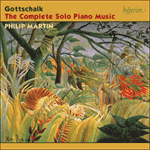
Welcome to Hyperion Records, a British classical label devoted to presenting high-quality recordings of music of all styles and from all periods from the twelfth century to the twenty-first.
Hyperion offers both CDs, and downloads in a number of formats. The site is also available in several languages.
Please use the dropdown buttons to set your preferred options, or use the checkbox to accept the defaults.

To commemorate this sad event he revised a Marche funèbre that he had written some years earlier (‘for a careful exposition of these two variant editions’, notes Starr, ‘see Doyle, Louis Moreau Gottschalk, D-90, D-90a, D-90b, D-90c’). The source of its inspiration is obvious, its key the predictable B flat minor, yet its powerful central (G minor) section and some surprising harmonic progressions make it an effective example of its type.
In December 1853, Gottschalk retreated to his birthplace and thence to Cuba where, for the next three years, he struggled to rebuild his life.
from notes by Jeremy Nicholas © 2003
Pour commémorer ce triste événement, il révisa une Marche funèbre composée quelques années auparavant («pour un exposé détaillé de ces deux éditions différentes, note S. Frederick Starr, voir : Doyle, Louis Moreau Gottschalk, D-90, D-90a, D-90b, D-90c»). La source de son inspiration est évidente, sa tonalité, de manière prévisible, si bémol mineur, mais sa puissante section centrale (en sol mineur) et quelques progressions harmoniques surprenantes en font un représentant réussi de ce genre.
En décembre 1853, Gottschalk se réfugia dans sa ville d’origine avant de partir pour Cuba où il passa trois ans à lutter pour reconstruire sa vie.
extrait des notes rédigées par Jeremy Nicholas © 2003
Français: Josée Bégaud
Im Dezember 1853 zog sich Gottschalk zunächst in seinen Geburtsort und dann nach Kuba zurück, wo er in den folgenden drei Jahren mühsam versuchte, seine Existenz wieder aufzubauen.
aus dem Begleittext von Jeremy Nicholas © 2003
Deutsch: Viola Scheffel
 Gottschalk: The Complete Solo Piano Music Gottschalk: The Complete Solo Piano MusicWith his idiomatic and graceful style, pianist Philip Martin has established himself as the foremost exponent of Gottschalk. The composer had a unique spontaneity and individuality which Martin’s performances bring vividly to the fore. The complet ...» More |

